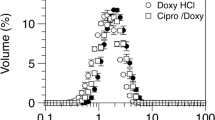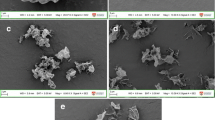ABSTRACT
Purpose
Release profiles of two ciprofloxacin hydrochloride formulations for the treatment of respiratory infection were evaluated using different in vitro methodologies and characterised for aerosol performance and toxicity.
Methods
Spray-dried ciprofloxacin and ciprofloxacin spray-dried with polyvinyl alcohol as a controlled release (CR) agent at a 50:50 w/w ratio were formulated and physico-chemically characterised. Aerosol performances were assessed in vitro using a liquid impinger. Drug release was performed using a modified Franz cell and a validated air interface Calu-3-modified twin stage impinger (TSI). Ciprofloxacin toxicity was also established in vitro.
Results
Both formulations had a similar size distribution, while CR ciprofloxacin had superior aerosol performance and stability. The release profiles showed the CR formulation to have a higher transport rate compared to ciprofloxacin alone in the cell model. Contrary results were observed using the diffusion cell. Results suggest that the air interface cell model provides a more physiologically relevant model than the modified Franz cell. Toxicity analysis showed that the lung epithelial cells could tolerate a wide range of ciprofloxacin concentrations.
Conclusions
This study establishes that the in vitro modified TSI air interface Calu-3 model is capable of evaluating the fate of inhaled powder formulations.









Similar content being viewed by others
REFERENCES
Traini D, Young PM. Delivery of antibiotics to the respiratory tract: an update. Expert Opin Drug Deliv. 2009;6(9):897–905.
Murray TS, Egan M, Kazmierczak BI. Pseudomonas aeruginosa chronic colonization in cystic fibrosis patients. Curr Opin Pediatr. 2007;19(1):83–8.
Adi H, Young PM, Chan H-K, Salama R, Traini D. Controlled release antibiotics for dry powder lung delivery. Drug Dev Ind Pharm. 2010;36(1):119–26.
Salama RO, Traini D, Chan H-K, Young PM. Preparation and characterisation of controlled release co-spray dried drug-polymer microparticles for inhalation 2: evaluation of in vitro release profiling methodologies for controlled release respiratory aerosols. Eur J Pharm Biopharm. 2008;70(1):145–52.
Widdicombe JH. Regulation of the depth and composition of airway surface liquid. J Anat. 2002;201(4):313–8.
Salama R, Ladd L, Chan H-K, Traini D, Young P. Development of an ovine dry powder inhalation model for the evaluation of conventional and controlled release microparticles. AAPS J. 2009;11(3):465–8.
Haghi M, Young PM, Traini D, Jaiswal R, Gong J, Bebawy M. Time- and passage-dependent characteristics of a Calu-3 respiratory epithelial cell model. Drug Dev Ind Pharm. 2010;36:1207–14.
Grainger CI, Greenwell LL, Lockley DJ, Martin GP, Forbes B, Grainger CI, et al. Culture of Calu-3 cells at the air interface provides a representative model of the airway epithelial barrier. Pharm Res. 2006;23(7):1482–90. Comparative Study Research Support, Non-U.S. Gov’t.
Bur M, Lehr CM, Bur M, Lehr C-M. Pulmonary cell culture models to study the safety and efficacy of innovative aerosol medicines. Expert Opin Drug Deliv. 2008;5(6):641–52. Research Support, Non-U.S. Gov’t Review.
Cavet M, West M, Simmons N. Transepithelial transport of the fluoroquinolone ciprofloxacin by human airway epithelial Calu-3 cells. Antimicrob Agents Chemother. 1997;41(12):2693–8.
Ehrhardt C, Kneuer C, Bies C, Lehr C-M, Kim K-J, Bakowsky U. Salbutamol is actively absorbed across human bronchial epithelial cell layers. Pulm Pharmacol Ther. 2005;18(3):165–70. Research Support, Non-U.S. Gov’t, Research Support, U.S. Gov’t, P.H.S.
Fiegel J, Ehrhardt C, Schaefer UF, Lehr C-M, Hanes J. Large porous particle impingement on lung epithelial cell monolayers—toward improved particle characterization in the lung. Pharm Res. 2003;20(5):788–96.
Mathias NR, Timoszyk J, Stetsko PI, Megill JR, Smith RL, Wall DA. Permeability characteristics of Calu-3 human bronchial epithelial cells: in vitro—in vivo correlation to predict lung absorption in rats. J Drug Target. 2002;10(1):31–40.
Yan Z, Aaron C, Thomas H. Cultured human airway epithelial cells (Calu-3): a model of human respiratory function, structure, and inflammatory responses. Crit Care Res Pract. 2010;2010
Grainger CI, Greenwell LL, Martin GP, Forbes B. The permeability of large molecular weight solutes following particle delivery to air-interfaced cells that model the respiratory mucosa. Eur J Pharm Sci. 2009;71(2):318–24.
Moazeni E, Gilani K, Sotoudegan F, Pardakhty A, Najafabadi AR, Ghalandari R, et al. Formulation and in vitro evaluation of ciprofloxacin containing niosomes for pulmonary delivery. J Microencapsul. 2010;27(7):618–27.
Adi H, Young PM, Chan H, Stewart P, Agus H, Traini D. Cospray dried antibiotics for dry powder lung delivery. J Pharm Sci. 2007
Yamamoto A, Yamada K, Muramatsu H, Nishinaka A, Okumura S, Okada N, et al. Control of pulmonary absorption of water-soluble compounds by various viscous vehicles. Int J Pharm. 2004;282(1–2):141–9.
Salama RO, Traini D, Chan HK, Sung A, Ammit AJ, Young PM. Preparation and evaluation of controlled release microparticles for respiratory protein therapy. J Pharm Sci. 2009;98(8):2709–17.
Salama R, Hoe S, Chan H-K, Traini D, Young PM. Preparation and characterisation of controlled release co-spray dried drug-polymer microparticles for inhalation 1: influence of polymer concentration on physical and in vitro characteristics. Eur J Pharm Biopharm. 2008;69(2):486–95.
Franz TJ. Percutaneous absorption on the relevance of in vitro data. J Investig Dermatol. 1975;64(3):190–5.
Moore JW, Flanner HH. Mathematical comparison of dissolution profiles. Pharm Technol. 1996;20(6):64–74.
Adi S, Adi H, Tang P, Traini D, Chan H-K, Young PM. Micro-particle corrugation, adhesion and inhalation aerosol efficiency. Eur J Pharm Sci. 2008;35(1–2):12–8.
Chew NYK, Tang P, Chan H-K, Raper JA. How much particle surface corrugation is sufficient to improve aerosol performance of powders? Pharm Res. 2005;22(1):148–52.
Yang Y, Tsifansky MD, Wu CJ, Yang HI, Schmidt G, Yeo Y. Inhalable antibiotic delivery using a dry powder co-delivering recombinant deoxyribonuclease and ciprofloxacin for treatment of cystic fibrosis. Pharm Res. 2010;27(1):151–60.
Sweeney LG, Wang Z, Loebenberg R, Wong JP, Lange CF, Finlay WH. Spray-freeze-dried liposomal ciprofloxacin powder for inhaled aerosol drug delivery. Int J Pharm. 2005;305(1–2):180–5.
Administration FaD. Guidance for industry; dissolution testing of immediate release solid oral dosage forms. August 1997
Polli JE, Rekhi GS, Augsburger LL, Shah VP. Methods to compare dissolution profiles and a rationale for wide dissolution specifications for metoprolol tartrate tablets. J Pharm Sci. 1997;86(6):690–700.
Author information
Authors and Affiliations
Corresponding author
Rights and permissions
About this article
Cite this article
Ong, H.X., Traini, D., Bebawy, M. et al. Epithelial Profiling of Antibiotic Controlled Release Respiratory Formulations. Pharm Res 28, 2327–2338 (2011). https://doi.org/10.1007/s11095-011-0462-1
Received:
Accepted:
Published:
Issue Date:
DOI: https://doi.org/10.1007/s11095-011-0462-1




